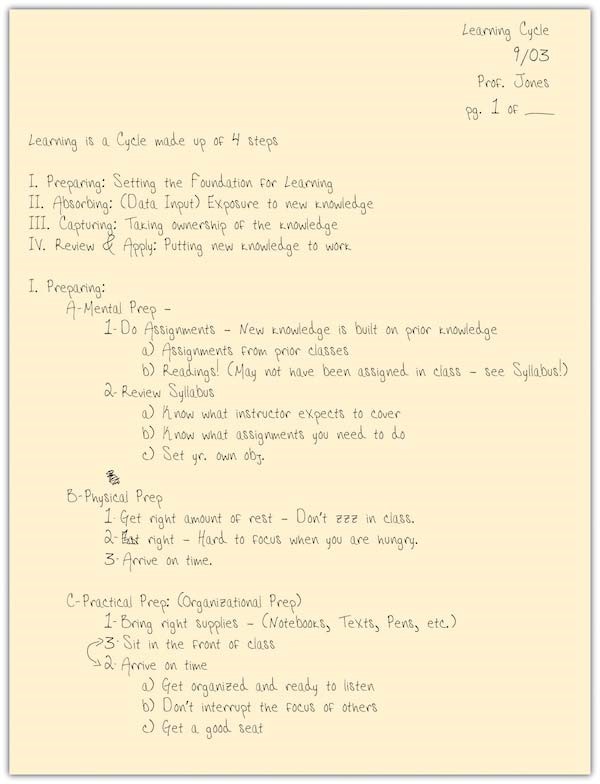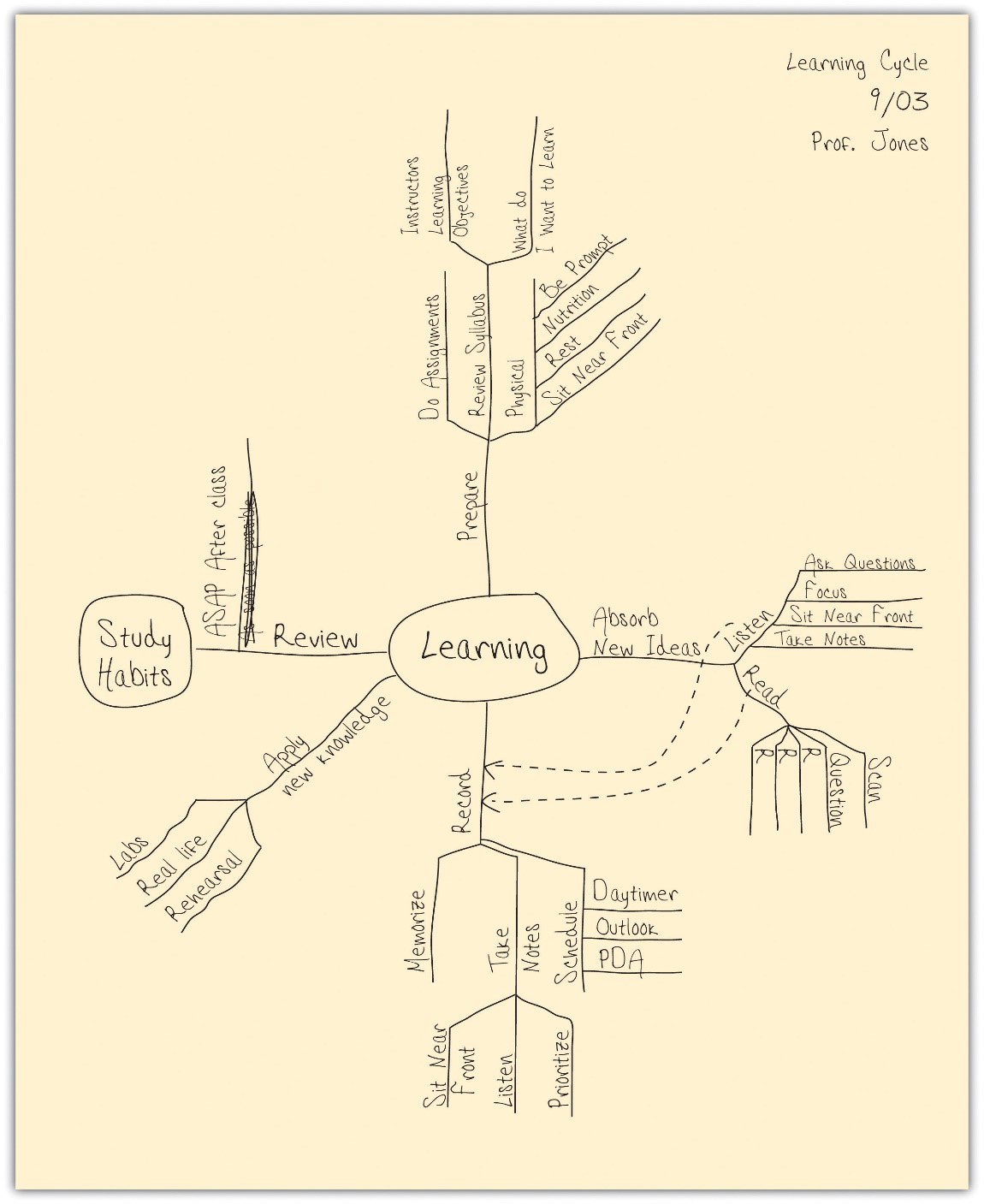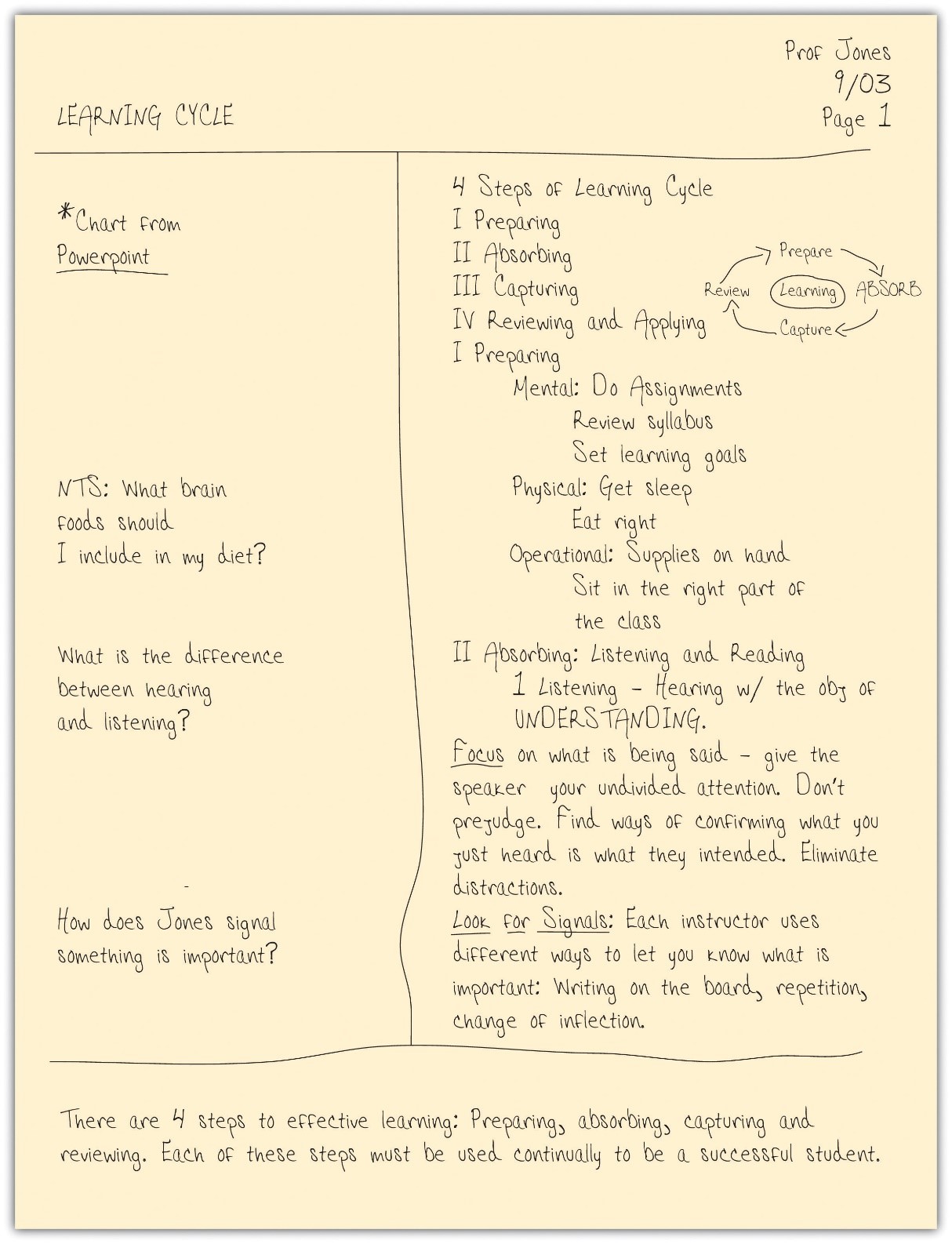Taking Notes
Stacey Corbitt
Chapter Overview
College is the place where young adults get many opportunities to gain experience – and sometimes fail spectacularly! – in a relatively safe environment. For that reason, this is the perfect time to experiment with new and different ways to engage with coursework and study habits. Spending time now to explore some proven methods of note-taking will increase your chances of academic success and carry over to professional success. This chapter aims to help students develop and learn to employ a method for taking well-organized, usable notes with the goal of improving the learner’s experiences in college and beyond.
Taking notes in lectures
One difference between high school and college that many new college students learn early in their first semester is an expansion of note-taking. Were you taught to take notes in high school lecture classes, and reminded by your instructor to write information down, and even graded or quizzed on your class notes? Whether or not your high school experience included practice at taking notes, expect college coursework to present constant opportunities to write and review notes as part of your learning process. You will take notes in college in an effort to understand and remember new material, as well as to draw connections with what you already know.
College instructors have traditionally presented lessons in the form of lectures; and this material delivery method for higher education continues to be common for many disciplines, particularly in the first- and second-year level of university education. Whether large class sizes and venues make lectures the most efficient means of sharing information, or another set of circumstances dictate, college students can expect to get plenty of practice watching and listening to professors present lectures. Developing keen listening skills (discussed in another chapter) and a working method of note-taking for lectures is imperative to college success.
Taking notes in research
Students have continuous opportunities to experiment with note-taking methods for classroom-based learning: additionally, research assignments as well as opportunities to actively participate in scholarly research afforded to students may necessitate additional levels of note-taking skills. Primary research activities, for example, may lend themselves to taking notes in laboratory notebooks or field observation logbooks. Secondary research efforts benefit from students’ ability to summarize and paraphrase source materials in real time while attaching citation information.
Note-taking styles
The information in this section was adapted from Success in College, “Chapter 4: Listening, taking notes, and remembering” (2012). The following table summarizes four of the most common methods of taking notes during lecture classes, research, and self-study sessions.
| Method | Description | When to Use |
|---|---|---|
| Lists | A sequential listing of ideas as they are presented. Lists may be short phrases or complete paragraphs describing ideas in more detail. | This method is what most students use as a fallback if they haven’t learned other methods. This method typically requires a lot of writing, and you may find that you are not keeping up with the professor. It is not easy for students to prioritize ideas in this method. |
| Outlines | The outline method places most important ideas along the left margin, which are numbered with roman numerals. Supporting ideas to these main concepts are indented and are noted with capital letters. Under each of these ideas, further detail can be added, designated with an Arabic number, a lowercase letter, and so forth. | A good method to use when material presented by the instructor is well organized. Easy to use when taking notes on your computer. |
| Concept Maps | When designing a concept map, place a central idea in the center of the page and then add lines and new circles in the page for new ideas. Use arrows and lines to connect the various ideas. | Great method to show relationships among ideas. Also good if the instructor tends to hop from one idea to another and back. |
| Cornell Method | The Cornell method uses a two-column approach. The left column takes up no more than a third of the page and is often referred to as the “cue” or “recall” column. The right column (about two-thirds of the page) is used for taking notes using any of the methods described above or a combination of them. After class or completing the reading, review your notes and write the key ideas and concepts or questions in the left column. You may also include a summary box at the bottom of the page, in which to write a summary of the class or reading in your own words. | The Cornell method can include any of the methods above and provides a useful format for calling out key concepts, prioritizing ideas, and organizing review work. Most colleges recommend using some form of the Cornell method. |
Take a closer look at each of the featured methods of note-taking. All styles present some challenges, advantages, and disadvantages, as demonstrated in the examples provided below (adapted from Success in College, 2012). Try to keep an open mind to trying something new:
List method
Success in College (2019) describes the first method in this way:
Take a look at the example page of notes presented as Figure 1 on the next page. Have you employed the list method of taking notes in the past? What do you see as the disadvantages of relying on this note-taking method?
The passage above, quoted from Success in College, recommends that you “…transcribe your notes to [another] method after class….” Do you consider this extra work a disadvantage to the list method of note-taking? How might rewriting your notes benefit your learning?
Figure 1: Example notes demonstrating the list method (Success in College, 2019).

Outlining method
According to Success in College (2019),
The advantage of the outline method is that it allows you to prioritize the material. Key ideas are written to the left of the page, subordinate ideas are then indented, and details of the subordinate ideas can be indented further.
_____________________________________
At first you may have trouble identifying when the instructor moves from one idea to another. This takes practice and experience with each instructor, so don’t give up! In the early stages you should use your syllabus to determine what key ideas the instructor plans to present. Your reading assignments before class can also give you guidance in identifying the key ideas.
If you’re using your laptop computer for taking notes, a basic word processing application… is very effective. Format your document by selecting the outline format from the format bullets menu. Use the increase or decrease indent buttons to navigate the level of importance you want to give each item.
_____________________________________
After class be sure to review your notes and then summarize the class in one or two short paragraphs using your own words. This summary will significantly affect your recall and will help you prepare for the next class.
Students sometimes have experience with outlining when they begin college: perhaps a high school teacher presented class materials in outline format, or writing assignments required development of an outline. Think about outlining in your past experience, either with writing assignments or note-taking. Considering the courses in which you are currently enrolled, use the space below to discuss in which of those courses you might try taking notes using the outline method. What do you know about the lectures or work in that class that makes you think outline note-taking would work?
Figure 2 on the next page presents an example of notes taken using the outlining method.
Figure 2: Example notes demonstrating the outline method (Success in College, 2019).
Mind-mapping/concept mapping method
Success in College (2019) describes the third method of taking notes we will study as one that is “very graphic” in nature:
Figure 3 below introduces the mapping method of taking notes.
To develop a concept map, start by using your syllabus to rank the ideas you will listen to by level of detail (from high-level or abstract ideas to detailed facts). Select an overriding idea (high level or abstract) from the instructor’s lecture and place it in a circle in the middle of the page. Then create branches off that circle to record the more detailed information, creating additional limbs as you need them.
Figure 3: Example notes demonstrating the mapping method (Success in College, 2019).
Cornell method
Finally, the fourth note-taking method to explore in this chapter includes an engineered structure that was developed at Cornell University a half-century ago. Rather than developing organically like the previous three methods, Cornell-style note-taking prescribes a format (see Figure 4) that is often recommended by lecturers for use by college students.
Figure 4: Example notes demonstrating the Cornell method (Success in College, 2019).
The Cornell method follows a very specific format that consists of four boxes: a header, two columns, and a footer.
The header is a small box across the top of the page. In it you write identification information like the course name and the date of the class. Underneath the header are two columns: a narrow one on the left (no more than one-third of the page) and a wide one on the right. The wide column, called the “notes” column, takes up most of the page and is used to capture your notes using any of the methods outlined earlier. The left column, known as the “cue” or “recall” column, is used to jot down main ideas, keywords, questions, clarifications, and other notes. It should be used both during the class and when reviewing your notes after class. Finally, use the box in the footer to write a summary of the class in your own words. This will help you make sense of your notes in the future and is a valuable tool to aid with recall and studying.
A final thought from the source
Chapter conclusion
College writers experience a transformation from being students who are told by teachers what to write down and recall from their study materials to adults who are largely responsible for their own advanced learning. While instructors employ various means of encouraging students to take notes in lectures, laboratories, and while conducting research, students must learn to develop their own study materials by taking useful, clear, and complete notes during all learning activities. Many variations of note-taking methods exist, and this chapter provides a cursory introduction to 4 of those methods. You are encouraged to try out all of the methods described here to determine your own best fit for setting up your success in understanding and recalling lessons. Finally, regardless of your ultimate choice of method(s), recognize that reviewing and summarizing your own notes early in the process is a significant key to success in the learning process.
Homework
Developmental writing assignment
Choose a lecture-based course you are taking now and use the Cornell method to take notes for one classroom session. Create a Cornell-style form to use in taking your class notes, and complete and submit a copy of your notes worksheet together with a post-class summary and a reflection memo about your experience.
Technical writing document creation assignment
Write and submit a summary and reflection memo comparing mind-mapping (or another of the methods discussed in this chapter) to the Cornell method. Discuss how the previous assignment and your other research inform your practice of note-taking.
References
Lardbucket.org (2012). Listening, taking notes, and remembering. In Schmitz, A. (Ed.), Success in College, V 1.0 (Chapter 4). License: CC-BY-NC-SA 3.0. https://2012books.lardbucket.org/books/success-in-college/
